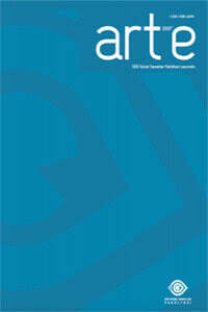GELECEK ODAKLI TASARIM PROJELERİNDE ÖĞRENCİ YAKLAŞIMLARININ DEĞERLENDİRİLMESİ1
EVALUATION OF STUDENTS' APPROACH TO FUTURE ORIENTED DESIGN PROJECTS
___
- Bell, W., (1997). Foundations of Futures Studies: Human Science for a New Era, C.1, Transaction Publishers, London.
- Bevolo, M. & Brand, R., (2003). "Brand Design For The Long Term", Design Management Journal, S.1.
- Broadbent, J. A., (2004). "A Future for Design Science?", International Symposium on the Development and Prospects of a PhD Programme in Design Science Education, Kaoyang University, Taiwan.
- Buchanan, R., (1992). "Wicked Problems in Design Thinking", Design Issues, C.8, S.2.
- Cross, N., (1981). "The Coming of Post-Industrial Design", Design Studies, C.2, S.1.
- Cross, N., (1989). Engineering Design Methods: Strategies for Product Design, John Wiley and Sons Ltd, Chichester, UK.
- Cross, N., (2006). Designerly Ways of Knowing, Springer, London.
- Cross, N.ve diğerleri, (1975). "Designing the Futures - Man Made Futures: Design and Technology" The Open University Course Material T2621, The Open University Press, Milton Keynes.
- David, H., (1970). "Challenges for the Future", Proceedings of the International Futures Research Conference, Kodansha, Kyoto.
- Design for Dreaming., (1956). http://publicdomainreview.org/collections/design-fordreaming-1956/ (Erişim tarihi: 26.02.2015).
- Dffn., (2003). Design for Future Needs, EC Report.
- Evans, M., & Sommerville, S. (2005). "Designing Tomorrow: A Methodology for Future Orientated Product Design", Global Chinese Industrial Design Conference 2005, Chang Gung University, Taiwan.
- Evans, M., & Sommerville, S. (2007). "Design Led Futures: Futures Thinking in the Design Curriculum", International Conference On Design Education, University Of New South Wales, Sydney.
- Glenn, J., (1994). Introduction to the Futures Research Methodology, Futures Research Methodology, The American Council of the United Nations University, New York.
- Glenn, J. C., (2003). Futures Research Methodology v2.0., American Council for the UNU. Hocaoğlu, D., (2015). "Contribution of Group Work and Comparative Education to Students' Learning: Analysis of Comparative Design History Course", Procedia - Social and Behavioral Sciences, S.174.
- Hugentobler. H. K. ve diğerleri, (2004). "Designing a Methods Platform for Design and Design Research", Futureground, DRS., Melbourne.
- Inayatullah, S., (2003). Causal Layered Analysis: Unveiling and transforming the future, Futures Research Methodology, Washington D.C.
- Inayatullah, S., (2008). "Six Pillars: Futures Thinking for Transforming", Foresight, C.10, S.1.
- Inayatullah, S., (2013). Futures Studies: Theories and Methods, There's a Future: Visions for a Better World, T.F. Editores.
- Jensen, C., (2005). Future Forecasts in Product Design - Guidelines to predicting the future. 08.04.2015 tarihinde http://www.ivt.ntnu.no/ipd/fag/PD9/2005/artikler/PD9artikkel_Camilla_Jensen.pdf adresinden alındı.
- Jonas, W., (2010). A Scenario for Design, The designed world : images, objects, environments, Berg Publishers, Oxford.
- Jonas, W., & Chow, R., (2010). MAPS. Theoretical Underpinnings, 26.02.2015 tarihinde http://www.design-research-lab.org/wp content/uploads/2011/08/MAP S_Theor etical_Underpinnings1. pdf adresinden alındı.
- Krippendorf, K., (2006). The Semantic Turn; A New Foundation For Design, Boca Raton, London.
- Kurzweil, R., (1999). The Age Of Spiritual Machines: When Computers Exceed Human Intelligence, Penguin Group, New York.
- Radcliffe, D. F., & Lee, T. Y., (1989). "Design Methods Used By Undergraduate Engineering Students", Design Studies, C.10, S.4.
- Raskin, P. vd., (2002). Great Transition, Stockholm Environment Institute, Boston.
- Ratner, E., (2007). "Teaching Visionary Thinking To Product Designers Using Lessons From Utopian Science Fiction", 10th International Conference on Engineering and Product Design Education, Northumbria University, Newcastle.
- Saurin, R., (2012). Workplace Futures: A Case Study of an Adaptive Scenarios Approach to Establish Strategies for Tomorrow's Workplace, Doctoral Thesis, Dublin Institute of Technology.
- Seymour, R., (2008). "Cover Story: Optimistic Futurism", Interactions, C.15, S.3. Toffler, A., (1981). Gelecek Korkusu, Altın Kitaplar Yayınevi, İstanbul.
- Yayın Aralığı: 2
- Başlangıç: 2008
- Yayıncı: Süleyman Demirel Üniversitesi Güzel Sanatlar Fakültesi
GÖLBAŞI (ANKARA) ÇÖMLEKÇİLİĞİNİN KORUNMASI, SORUNLARI VE ÇÖZÜM ÖNERİLERİ1
Ayşegül OKCA KOYUNCU, Ömer Paşa BUNER
Fotoğraftaki Gerçeklik Olgusu Ve Ölüm-Ölümsüzlük Karşıtlığı
Türk Çini Sanatında Kullanılan Hayvansal Figürlerin Seramik Yüzeyler Üzerinde Üç Boyutlu Uygulanması
Ayşe PAMUK, Naile Rengin OYMAN
Moda Giyim Sektöründe Üç Boyutlu Yazıcılarla Tasarım Ve Üretim
Gölbaşı (Ankara) Çömlekçiliğinin Korunması, Sorunları Ve Çözüm Önerileri
BİR ÖĞRENME ARACI OLARAK ETKİLEŞİMLİ E-KİTAP1
SEYAHATNAMELERE GÖRE GEREDE/BOLU EL SANATLARI1
Tekstil Sanatında Gelenekselden Çağdaşa Biçimsel Değişim
